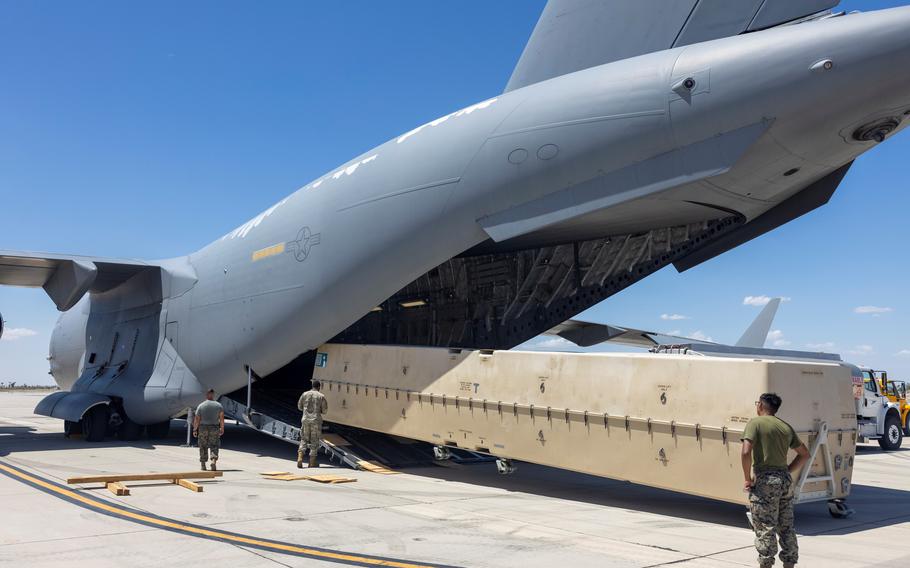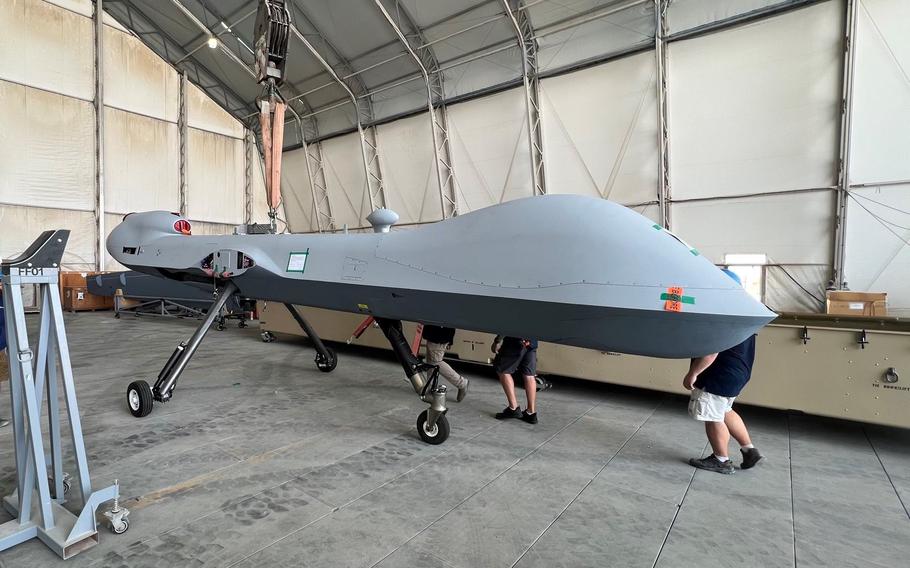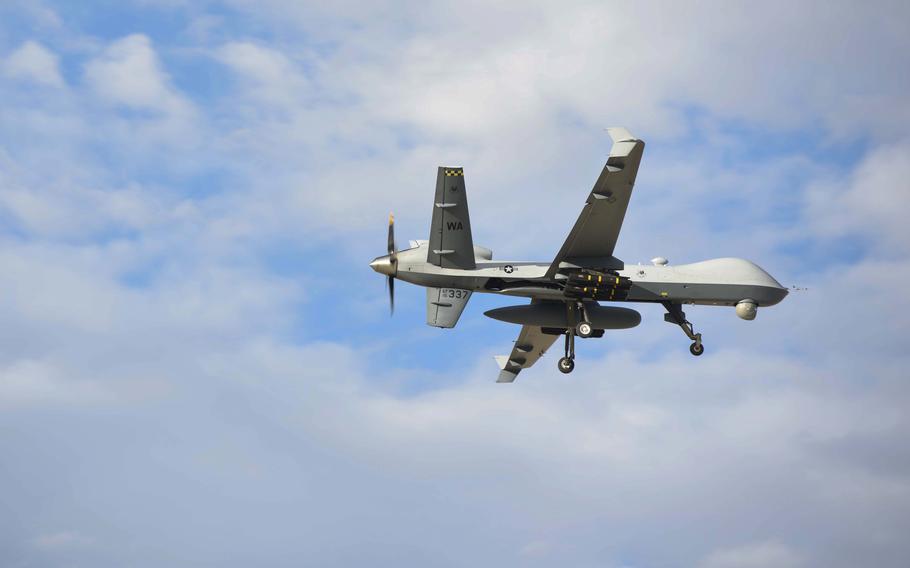
U.S. Marines load a boxed-up MQ-9 Reaper drone onto a cargo plane en route to the Middle East, in a photo released by Marine Corps Forces Central Command on Aug. 12, 2023. (U.S. Marine Corps)
Marines are increasingly using Reaper drones to patrol Middle East waterways as part of a strategy to stop Iran’s seizures and harassment of tankers moving through some of the world’s busiest shipping lanes.
Drone pilots who spoke with Stars and Stripes said they’ve been patrolling the Strait of Hormuz, a narrow passage near Iran that U.S. agencies have deemed “the world’s most important oil transit chokepoint.”
The MQ-9 Reapers can carry up to eight laser-guided missiles, but those on patrol are unarmed, Marine Corps officials said.
Parker, an enlisted MQ-9 sensor operator, said a typical mission gives him a set of parameters for a ship to look for, with details such as its size and speed.
The Reaper’s powerful sensor scans vast swaths of ocean, said Parker, who spoke with Stars and Stripes along with his colleagues on the condition that their full names not be revealed because of security concerns.
The data they get back maps the water “and any surface vessels that may be of interest to us,” Parker said.

Workers walk past a recently assembled Marine Corps MQ-9A Reaper aerial drone in a hangar in the Middle East on Sept. 8, 2023. (U.S. Marine Corps)
The U.S. accuses Iran of smuggling arms on ships to militant proxy groups, as well as drugs to help fund those groups. The Navy and the Coast Guard have joined with international partners to seize those vessels, which are often relatively simple watercraft attempting to evade authorities.
Iran has retaliated, the U.S. says, by seizing lawfully operated commercial ships. Tehran has seized or harassed about 20 such vessels, including the Marshall Islands-flagged oil tanker Advantage Sweet in late April and the Panama-flagged Niovi in May.
That prompted the U.S. Navy to announce an increase in patrols by ships and aircraft in the Persian Gulf.
Reconnaissance missions carried out by Marine drone crews have been a crucial component of those patrols, U.S. Central Command chief Gen. Michael “Erik” Kurilla said in a recent emailed statement.
“The team’s extended on-station times provide much-needed overlap between other maritime patrol and reconnaissance aircraft,” Kurilla said. “This makes life much more difficult for our adversaries even in a complex environment, which is exactly what you expect of U.S. Marines.”
While specific numbers are classified for operational security reasons, a Marine Reaper squadron would have six to 10 drones at full strength, said James, a Marine MQ-9 pilot.

A U.S. Air Force MQ-9 Reaper remotely piloted aircraft lifts off from Marine Corps Air-Ground Combat Center, Twentynine Palms, Calif., Aug. 15, 2023. (Victoria Nuzzi/U.S. Air Force)
The service said in August that it was deploying two additional drones to the region, which James confirmed are now in use.
The Marines have a goal of operating more MQ-9 Reapers as part of Force Design 2030, which seeks to ready the Corps for potential conflict with larger adversaries like China or Russia.
The experience of flying the Reapers in the Middle East will be useful elsewhere, James said.
“Our pilots are learning how to fly the MQ-9 in international airspace that is often very tight, with little room for error,” James said.
In 2021, the Marines acquired their first two Reapers, which they had previously leased. The service created a new job specialty for Reaper pilots in 2020.
Compared with previous aerial drones used by the Marines, Reapers are larger, fly longer distances and can carry more sensors, said Dan Gettinger, a drone expert and the director of communications at the Virginia-based Vertical Flight Society.
The longer range could prove useful over the vast distances of the Pacific Ocean if a war breaks out there, he said.
“The MQ-9 plays into the Marine Corps’ evolving concept for itself and for the way that it wants to employ technology,” Gettinger said. “The long-standing American presence in the (Persian) Gulf provides a good opportunity to test these capabilities out.”